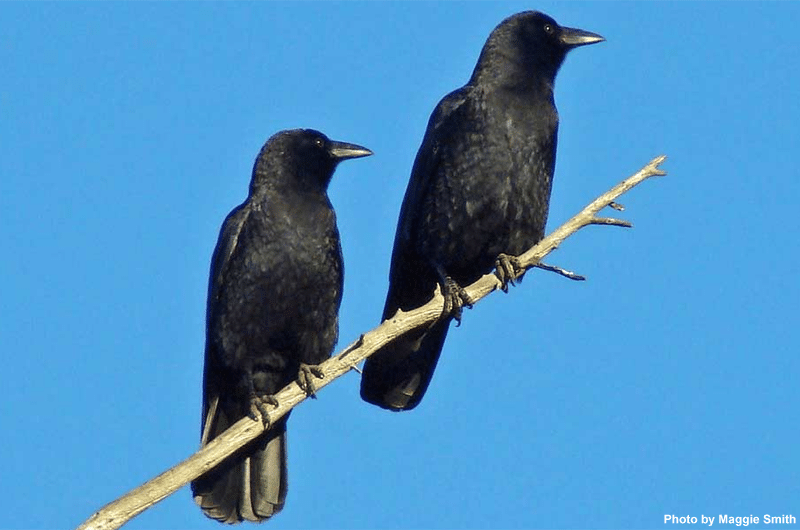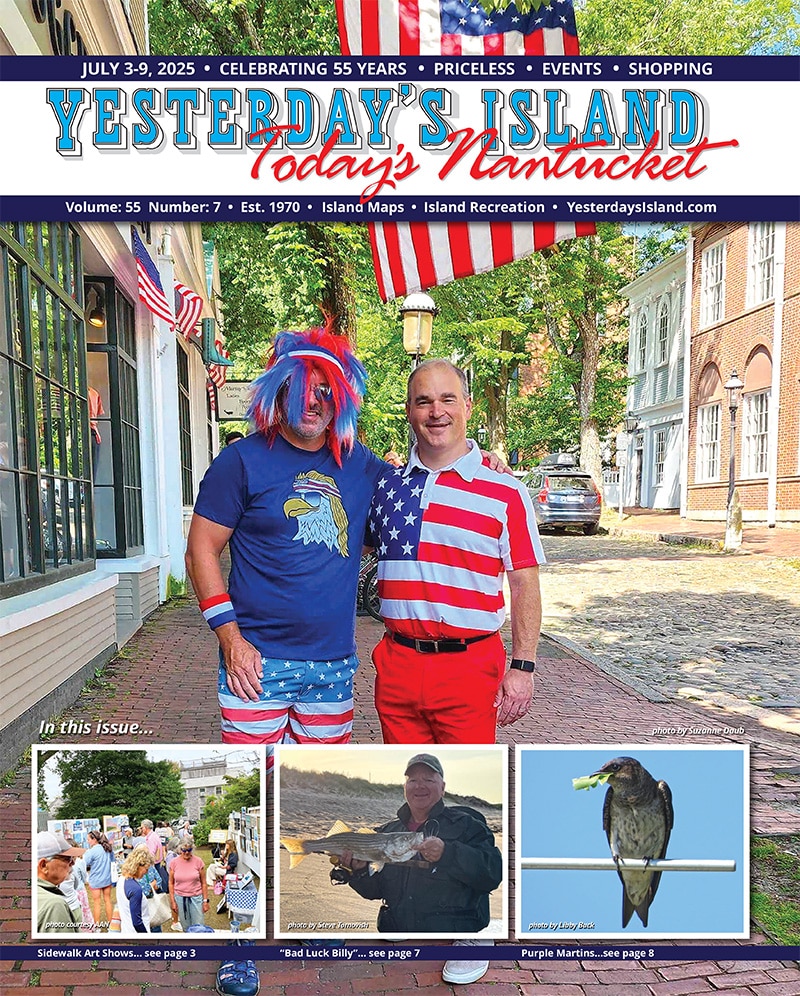~ by Dr. Sarah D. Oktay, Director, University of Massachusetts Nantucket Field Station ~
I have always been fascinating by crows, we have several very vocal ones here at the field station that will fly off in a huff when you disturb them while walking the trails. Every day I am treated to a red winged black bird/crow “Game of Thrones” type saga as they both fight over nesting areas and territory. The barn swallows flit around minding their own business and trying to avoid the loud neighborhood fights. Crows are exceptionally bright. One of the best science fair projects I judged was submitted by three boys at the Nantucket High School in which they observed crow behavior and described quite accurately the crow habit of setting a lookout to watch for larger birds or people while their compatriots eat carrion in the road.
I enjoy Ken Blackshaw’s books “Birds of Nantucket” and his article about crows can be found online at http://k-blackshaw.com/Birds%20of%20Nantucket/2004-07-02%20American%20Crow.htm. He talks about his grandfather who had a “talking crow” as a child while living across the marsh from Field Station at Quaise and tell “good and bad crow” stories. He also describes their tendency to roost in huge crowds in the same location. Perhaps no other very common bird except for maybe the often maligned seagull evokes such strong feelings as the American Crow. Their loud coarse cries are unmistakable and their expansion and huge numbers in the United States in addition to their inhabitation of human landscapes means they are a commonly seen bird. Their larger cousin the Raven has an even more entrenched place in our legends, movies, and poetry.
There are two species of crows along the East Coast: the American and Fish crow. The Fish crow is seen on the Cape but has not been observed often (ever?) on Nantucket. Fish Crows (Corvus ossifragus), as their name suggests, are usually associated with bodies of water. Nantucket and most of the U.S. is home to the American Crow (Corvus brachyrhynchos) which is a large passerine bird species of the family Corvidae. America crows are all back and about 17—21 inches from beack to tip of their tail. They are smaller than ravens (C. corax) and have a different call than a fish crow (C. ossifragus). From Wikipedia (https://en.wikipedia.org/wiki/Corvidae): “Corvidae is a cosmopolitan family of oscine passerine birds that contains the crows, ravens, rooks, jackdaws, jays, magpies, treepies, choughs, and nutcrackers. In common English, they are known as the crow family, or, more technically, corvids. Over 120 species are described. The genus Corvus, including the jackdaws, crows, and ravens, makes up over a third of the entire family. They are considered the most intelligent of the birds, and among the most intelligent of all animals, having demonstrated self-awareness in mirror tests (European magpies) and tool-making ability (crows, rooks) skills until recently regarded as solely the province of humans and a few other higher mammals. Their total brain-to-body mass ratio is equal to that of great apes and cetaceans, and only slightly lower than in humans.”
American crows are common, widespread and adaptable, but they are highly susceptible to the West Nile virus. They are monitored as a bioindicator species that can be used to monitor the health of an environment or ecosystem. The Cornell Lab of Ornithology sponsors a very helpful website called “All about Birds” so that is the first place I stopped to learn about my chatty tenants (http://www.allaboutbirds.org/guide/American_Crow/lifehistory): “American Crows are familiar over much of the continent: large, intelligent, all-black birds with hoarse, cawing voices. They are common sights in treetops, fields, and roadsides, and in habitats ranging from open woods and empty beaches to town centers. They usually feed on the ground and eat almost anything – typically earthworms, insects and other small animals, seeds, and fruit but also garbage, carrion, and chicks they rob from nests. Their flight style is unique, a patient, methodical flapping that is rarely broken up with glides. American Crows are highly adaptable and will live in any open place that offers a few trees to perch in and a reliable source of food. Regularly uses both natural and human created habitats, including farmland, pasture, landfills, city parks, golf courses, cemeteries, yards, vacant lots, highway turnarounds, feedlots, and the shores of rivers, streams, and marshes.”
Crows live in large families, they do not reach breeding age until anywhere from 2-4 years of age. The young stick around with the parents for the first few years helping to raise their siblings. Some crows may stay in an area all year while others migrate, so they are consider partially migratory. Their migration depends on the resources available and the lowest temperatures in winters. Crows down south typically do not migrate. One of the most notable and fascinating aspects of a crow’s life is that fact that they roost (rest overnight) in large crowds of tens to thousands to up to 2 million (observed in Fort Cobb Oklahoma) birds. This crowd roosting starts in fall and extends into the winter, typically ending around March at the beginning of nest building and breeding times. And as we all know, a gathering of crows is called a murder. There are many theories for the origin of this name (http://www.pbs.org/wnet/nature/a-murder-of-crows-crow-facts/5965/) from the fact that we used to name large groups of animals in colorful ways to the carrion eating nature of crows and their somewhat ominous gatherings.
The loud crow arguments at the Nantucket Field Station are due to the fact that they like to prey on other bird’s young, so yes, something is getting murdered sometimes when they are around. Just a few weeks ago I saw two crows gang up and drive off a robin from her nest and then clean it out. Crows eats the eggs and nestlings of many species including sparrows, robins, jays, terns, loons, and eiders. They are the ultimate omnivores eating fish, worms, carrion, berries and everything in between.
For years, probably decades there has been a crow hunt on island in reaction to the large groups of winter roosting birds. I can understand why people may dislike crows when they see them harassing and killing other birds, but unless you plan to eat crow (and I am pretty sure few people do) I don’t see a need to kill them. We have all heard the phrase “to eat crow” to typify doing something distasteful. The idea that crows taste bad may come from the fact that they eat carrion, few people hanker for the flesh of carrion eaters. Literally eating a crow is traditionally seen as being distasteful; the crow is one of the birds listed in Leviticus chapter 11 as being unfit for eating. They are killed in Kansas and Oklahoma to mitigate their seed stealing.
From http://www.birds.cornell.edu/crows/crowfaq.htm we can examine some theories on why we may be seeing more crows today than in the past: “The 1972 extension of the Federal Migratory Bird Treaty Act of 1918 to cover crows. At this point the hunting of crows became regulated. No longer could anyone anywhere take shots at crows, but had to do so (theoretically) within proscribed guidelines and hunting seasons. It is possible that this change may have resulted in the decrease of shooting pressure on crows, allowing them to become more tolerant of the presence of people.”
Crows are extremely smart and will follow birds back to their nest to steal their eggs. They use tools to obtain food and steal food from other animals. From the “All about birds” website “They sometimes steal food from other animals. A group of crows was seen distracting a river otter to steal its fish, and another group followed Common Mergansers to catch minnows the ducks were chasing into the shallows. They also sometimes follow songbirds as they arrive from a long migration flight and capture the exhausted birds. Crows also catch fish, eat from outdoor dog dishes, and take fruit from trees.” While conducting research at the Blue Hills Observatory up near Boston I had a dickens of a time keeping crows from stealing the aluminum foil off the top of my rainwater samplers. In parking lots, seagulls would steal the foil looking for junk food treats, in the woods crows would steal it within seconds of me placing mu mice clean apparatus out to collect rain water. I am sure they were thinking “hey that’s shiny and pretty and it might be food.
I could go on for days talking about crows and we have just scratched the surface. For more facts from an expert, I recommend reading articles by Dr. Kevin J. McGowan who studies crows and helps educate the public on avian topics. His web page has a cornucopia of crow facts, tagging news, and research. Check it out at http://www.birds.cornell.edu/crows/crowinfo.htm. He is also the creator of the “All about Birds” index page on crows and he conducts a popular online home study ornithology course. Please look up Vern Laux’s and Edith Andrew’s articles on crows too; we are lucky to be on an island full of exceptional bird experts.



